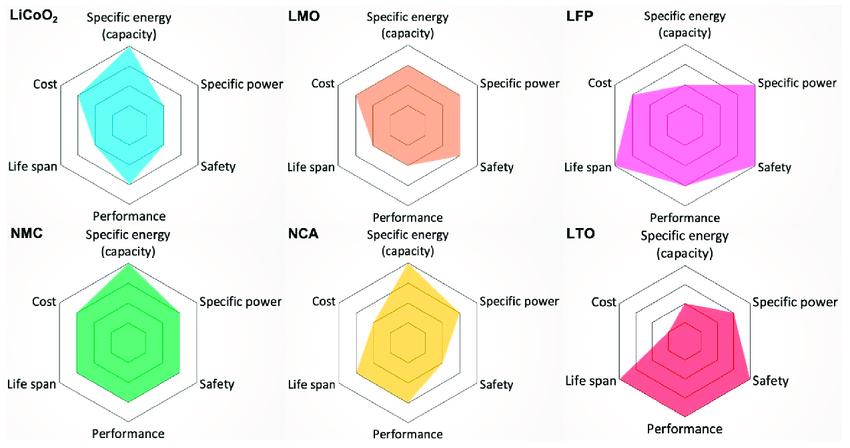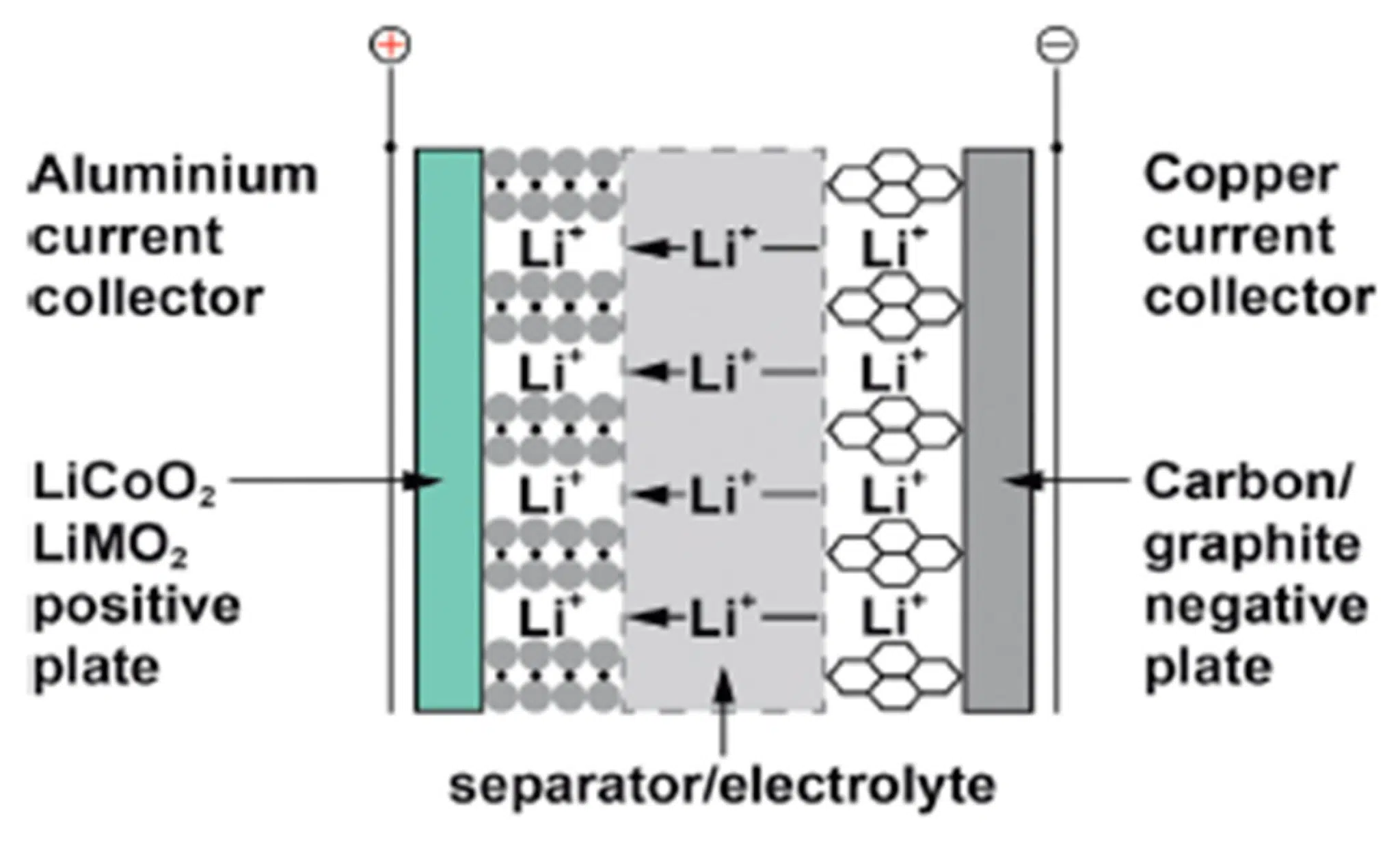
ملخص
منذ اختراع البطاريات وتسويقها في السبعينيات, تطورت بطاريات الليثيوم أيون من توفير الطاقة إلى الأجهزة الصغيرة والإلكترونية إلى تزويد الكهرباء بالشاحنات التي تصل إلى وزنها 60 طن, جعل السوق ناضجًا ومهمًا.
تعزز سياسات وشركات الحكومات في جميع أنحاء العالم تطورها, صنع بطاريات ليثيوم أيون (تُعرف أيضًا باسم بطاريات الليثيوم أيون) ليس فقط توفير انبعاثات أقل من المولدات التي تستخدم الطاقة غير المتجددة, ولكن تأتي أيضًا مع تكاليف أقل ومزيد من خيارات الطاقة.
بعد عقود من الاختبار, ظهرت العديد من التكوينات الكهروكيميائية, لكل منها خصائصها الفريدة ومزايا السمة, مناسب للمنتجات في صناعات مختلفة.
في هذه المقالة, سيتم تقديم ستة أنواع مختلفة من كيمياء بطارية الليثيوم أيون, الذي أعتقد أنه سيكون مفيدًا لك.
1.ما هي أنواع البطاريات الموجودة في أنظمة الألواح الشمسية?
عند مناقشة أنظمة الألواح الشمسية, الأنواع الرئيسية من البطاريات في السوق هي بطاريات حمض الرصاص وبطاريات الليثيوم أيون. السابق لديه سعر منخفض نسبيا, لكن حجم أكبر وحياة خدمة متوقعة بشكل عام بين 2 و 5 سنين.
على الرغم من أن بطاريات الليثيوم أيون أغلى من بطاريات حمض الرصاص, أدائهم أكثر استقرارًا وعمرهم المتوقع أطول (10 ل 12 سنين), جعلها تدريجيا المواد الأكثر شعبية في السوق.
فضلاً عن ذلك, هناك أنواع كيميائية أخرى من البطاريات التي تشغل موقفًا وسيطًا في الكفاءة والتكلفة, ولديهم أيضًا أسواقهم الخاصة بسبب وجهات نظر مختلفة واحتياجات التطبيق.
على سبيل المثال, يمكن لبطاريات الكادميوم النيكل تخزين الطاقة في درجات حرارة منخفضة, لكن كثافتها منخفضة, لذلك لا يمكنهم تخزين كمية كبيرة من الطاقة. بالمقارنة مع البطاريات المذكورة أعلاه, بطاريات هيدروجين النيكل لديها قدرة تخزين أعلى وتكاليف الصيانة المنخفضة مقارنة بالسنوات السابقة, وسيتم تفضيلها أيضًا من قبل السوق.
طاقة الليثيوم مجال بحث نشط وساخن, وتشمل حاليًا المواد الكيميائية الأكثر شعبية للبطارية:
ليثيوم نيكل المنغنيز الكوبالت (linixmnycozo2 أو إن إم سي)
ليثيوم نيكل أكسيد الألمنيوم (Linicoalo2 أو NCA)
فوسفات الحديد الليثيوم (LIFEPO4 أو LFP)
أكسيد الكوبالت الليثيوم (LICOO2 أو LCO)
أكسيد المنغنيز الليثيوم (limn2o4 أو الكائنات الحية المحورة)
تيتانات الليثيوم (li2tio3 أو طويل الأجل)
على الرغم من أن هذه كلها بطاريات الليثيوم, هناك اختلافات مختلفة بينهما.

2.الأنواع الكيميائية لبطاريات الليثيوم أيون
لتحليل وفهم الأنواع الكيميائية لبطاريات الليثيوم أيون, أولاً فهم شروط التقييم ذات الصلة, مما سيساعدك على فهم المفاهيم وإجراء مقارنات أفضل.
2.0.1 طاقة محددة
قدرة وقت التشغيل, معبر عنها في كيلووات ساعة لكل كيلوغرام.
2.0.2 قوة محددة
نقل القدرة تحت ارتفاع تيار, معبر عنها في واط لكل كيلوغرام。
2.0.3 حماية
الحكم بناءً على عتبة درجة حرارة الهرب الحراري
2.0.4 أداء
سعة, الجهد االكهربى, وتشير المقاومة أيضًا إلى أداء البطارية في درجات حرارة مختلفة.
2.0.5 خدمة الخدمة
إجمالي وقت الاستخدام لدورات تفريغ الشحن الكاملة للبطارية.
2.0.6 تكلفة الاستثمار
تكلفة المواد الخام, مكونات التجميع, والاستثمار في تكنولوجيا العمل.
2.1 أكسيد الكوبالت الليثيوم (LICOO2 أو LCO)

- طاقة نوعية عالية (كثافة الطاقة)
- قوة محددة محدودة
- أمن منخفض
- خدمة الخدمة القصيرة
بطاريات أكسيد الكوبالت الليثيوم, المعروف أيضًا باسم أكسيد الكوبالت الليثيوم أو بطاريات الكوبالت في أيون ليثيوم, كانت معروفة منذ ذلك الحين 1991. يمكن أن يشكل أكسيد الكوبالت الليثيوم تركيبة كيميائية بطارية عالية الطاقة, مع الكربون الجرافيت مثل الأنود وأكسيد الكوبالت ككاثود, وهيكل ذو طبقات يسهل حركة أيون.
الجهد الاسمي هو 3.7 فولت وكثافة الطاقة 150 إلى 180WH/كجم.
هذه الطاقة العالية المحددة ولكن أداء الطاقة المنخفضة يعني أنه يمكن تسليمها إلى أحمال الطاقة المنخفضة لفترة طويلة, لذلك تستخدم بطاريات LCO بشكل شائع في الهواتف الذكية, أجهزة لوحية, وأجهزة الكمبيوتر المحمولة.
لكن, هذا النوع من البطارية الكيميائية لديه درجة سلامة أقل, خاصة من حيث الاستقرار الحراري, نظرًا لأن القوة العالية يمكن أن تتسبب في ارتفاع درجة حرارة البطارية وزيادة خطر الهروب الحراري.
لذلك, إلى جانب عمره الأقصر ودورة الشحن, لم تعد بطاريات LCO هي الخيار الأكثر شعبية حيث تستثمر مختلف الصناعات في تقنيات البطارية الأخرى الأكثر فعالية من حيث التكلفة.
في أثناء, هناك سبب خاص أن تعدين الكوبالت ينطوي على انتهاكات لحقوق الإنسان. تزود جمهورية الكونغو الديمقراطية تقريبًا 70% من المواد الخام الكوبالت في العالم.
لكن, لا توجد قوانين العمل أو لوائح السلامة لدولة (على نطاق صغير) عمليات التعدين داخل مشروع تعدين الكوبالت في ثاني أكبر بلد في أفريقيا. التعدين اليدوي عالي الخطورة, توظيف عمل الأطفال أثناء عملية التعدين, وقد اكتسبت ظروف العمل السيئة صناعة تعدين الكوبالت عنوان "بطارية الدم".
يمكن أن تساعدنا بطاريات ليثيوم أيون خالية من الكوبالت في استخدام مواد البطارية الأخلاقية للبشر.
2.2 أكسيد المنغنيز الليثيوم (Limn2O4 أو LMO)

- تعزيز الأمن
- الاستقرار الحراري العالي
- حياة محدودة
- طاقة محددة متوسطة
- نسبة الطاقة المعتدلة
يشار عادة إلى بطاريات LMO باسم أكسيد المنغنيز الليثيوم, ليثيوم أيون المنغنيز, والمنغنيز الإسبنيل, وقد عرفت منذ ذلك الحين 1996. بنيته يشكل بنية إسبنيل ثلاثية الأبعاد أو إطار كريستال أكسيد أكسيد الليثيوم.
يمكن أن يحسن بنية الإسبنيل الحركة الحالية ومسار تدفق الأيونات, تقليل المقاومة الداخلية, وتحسين السلامة والاستقرار.
عزز تصميم المنغنيز الليثيوم عمر البطارية إلى أقصى حد, أمان, وقوة محددة. نظرًا للتكوين الكيميائي للبطاريات الهجينة التي يمكن أن تطيل عمر البطارية وتحسين طاقة البطارية المحددة, اختارت العديد من السيارات الكهربائية مثل BMW I3 و Nissan Leaf مجموعة LMO-NMC. يوفر مكون LMO تيارًا مرتفعًا أثناء التسارع, بينما يزيد NMC من نطاق القيادة.
2.3 فوسفات الحديد الليثيوم (LIFEPO4 أو LFP)

- إجراءات أمنية مشددة
- قوة محددة عالية
- دورة حياة طويلة
- طاقة محددة منخفضة
فوسفات الحديد الليثيوم هو نوع من LifePo4 أو LFP بطارية, واكتشاف الفوسفات كمواد الكاثود دفع تطور بطاريات الليثيوم القابلة لإعادة الشحن.
بعد عقود من التطوير والتطبيق, لقد أصبحت الآن مادة شائعة.
تستخدم بطاريات LFP بشكل أساسي لتخزين الطاقة والتطبيقات الأخرى التي تتطلب سلامة عالية, قوة عالية, وعمر طويل. الجهد الاسمي لبطاريات LIFEPO4 أقل, مما أدى إلى انخفاض طاقة محددة من بطاريات ليثيوم أيون الكوبالت.
على الرغم من أن كثافة الطاقة للتكوين الكيميائي لهذه البطارية أقل قليلاً (3.2v/الخلية), لديها حياة طويلة, انخفاض التكلفة, وأمان.
يمكنه حتى تحمل اختلافات درجة الحرارة الكبيرة جدًا, جعلها شائعة في الصناعات ذات الأحمال العالية والبيئات القاسية. لديها أداء كهروكيميائي جيد وزيادة التسامح مع الشحن الزائد للبطاريات, وهي شائعة أيضًا في المعدات المستخدمة في المواقع الثابتة ذات المتانة العالية.
جعل التقدم في تكنولوجيا كيمياء البطارية خطوة لا مفر منها لاستبدال البطاريات التقليدية. على سبيل المثال, يمكن لبطاريات فوسفات الليثيوم أن تحل محل بطاريات بداية الحشوة-بطاريات فوسفات الليثيوم تعمل بشكل جيد عندما يتم توصيل أربع بطاريات في سلسلة, إنتاج جهد يساوي الجهد الناتج عن ست بطاريات حمض الرصاص متصلة في سلسلة.
يعكس هذا أيضًا الأداء الممتاز والقدرة الاقتصادية لبطاريات LifePo4.
2.4 ليثيوم نيكل المنغنيز الكوبالت (linixmnycozo2 أو NMC)

- قوة محددة عالية
- طاقة نوعية عالية
- إجراءات أمنية مشددة
- تكلفة متوسطة
- أداء جيد بشكل عام
يعد الكوبالت المنغنيز النيكل الليثيوم أحد المواد الكيميائية الرائدة في سوق البطاريات من بين مواد أخرى. البطاريات, المعروف أيضا باسم NMC, NCM, إلخ., يمكن استخدامها كبطاريات طاقة أو بطاريات الطاقة.
بطارية NMC هي واحدة من أنجح منتجات بطارية الكاثود في ليثيوم أيون نيكل النيكل.
على أساس انخفاض تكاليف الإنتاج, يمكن أن يوفر أيضًا طاقة محددة للغاية ولديه سلامة جيدة. عن 2000 تثبت دورات الشحن أن لديها أيضًا حياة خدمة ممتازة.
الجهد الاسمي هو 3.6 فولت وكثافة الطاقة هي 150-220WH/كجم, مما يجعلها اختيارًا عالي الجودة في صناعة السيارات الكهربائية. الجمع بين مزايا النيكل (طاقة محددة عالية) والمنغنيز (تشكيل هياكل إسبنيل لتحقيق مقاومة داخلية منخفضة), تستخدم بطاريات NMC على نطاق واسع في الصناعات مثل الدراجات الكهربائية, سيارة كهربائية, والمعدات الطبية.
لدى NMC أيضًا أدنى معدل لتدفئة الذات بين التكوينات الستة, وخفيفة الوزن, حجم صغير, وقدرة تخزين الطاقة القوية تجعلها واحدة من الخيارات المثالية للمصنعين.
يمكن تكوين التركيب الكيميائي لـ NMC لاحتواء كميات مختلفة. تتكون صيغة NMC عادة من 33% النيكل, 33% المنغنيز, و 33% الكوبالت. أصبح الكوبالت مكلفًا بشكل متزايد ويصعب الحفاظ على المشتريات, نظرًا لأن العالم يدفع لتقليل استخدام الكوبالت إلى الحد الأدنى.
لذلك المزيج الفريد من 1-1-1 يجعل بطاريات NMC خيارًا جيدًا بسبب انخفاض محتوى الكوبالت وانخفاض تكاليف المواد الخام. لذلك, إنه خيار شائع في الصناعات التي تعتمد على دورات متكررة للتطبيقات الواسعة النطاق, مثل الإنتاج على نطاق واسع للبطاريات في السيارات وأنظمة تخزين الطاقة (ess).
هياكل المجموعة الناجحة الأخرى في تطبيقات السوق هي NMC811 و NMC622, وسلسلة NMC تنمو باستمرار للتكيف مع الأنظمة الكهروكيميائية لأيونات الليثيوم المختلطة NMC في السوق.
2.5 ليثيوم نيكل أكسيد الألمنيوم (Linicoalo2 أو NCA)

- طاقة نوعية عالية
- عمر خدمة طويل
- قوة وأداء ممتازة
- التكلفة والسلامة سيئة نسبيا مقارنة مع الآخرين
ليثيوم نيكل أكسيد الألمنيوم (NCA) البطاريات لها أوجه تشابه مع NMC من حيث أن لديها طاقة محددة عالية وبيانات طاقة محددة جيدة. في دراسة تقارن الطاقة المحددة للرصاص, القائم على النيكل, والأنظمة القائمة على الليثيوم, وقد وجد أن الألومنيوم الليثيوم (NCA) لديه أعلى طاقة محددة, و NCA لديها حياة عالية من أكثر 2000 دورات الشحن.
كثافة الطاقة تتراوح بين 200-260WH/كيلوغرام والجهد الاسمي من 3.6 فولت تجعل NCA خيارًا مثاليًا لأنظمة الطاقة, على الرغم من أن هذا التركيب الكيميائي يتطلب المزيد من الاهتمام لقضايا السلامة وهو مكلف.
لأن بطاريات NCA تحقق ثباتًا أعلى عن طريق إضافة الألومنيوم, ولكن في المواد الكيميائية للبطارية, كلما ارتفع محتوى النيكل, كلما زادت الطاقة المحددة, وأفقر ثبات البطارية. لذلك, تحتاج بطاريات NCA إلى اتخاذ المزيد من تدابير السلامة لضمان جودة البطارية وسلامة المستخدم.
يمكن لـ NCA تقديم التيارات الكبيرة نسبيًا لفترة طويلة والحفاظ على معدلات شحن عالية للشحن السريع. يمكن استخدام البطاريات التي تم تكوينها للسيارات الكهربائية عالية الأداء أو السيارات الكهربائية على الطرق الوعرة الشاقة (أوهفا), جعل NCA مادة مرشحة لأنظمة الطاقة الكهربائية.
2.6 تيتانات الليثيوم (li2tio3 أو lto)

- أمن ممتاز
- شحن سريع
- عمر خدمة طويل
- طاقة محددة منخفضة
منذ دخول السوق في 2008, كانت بطاريات تيتانيوم الليثيوم واحدة من أكثر بطاريات الليثيوم أيون أمانًا بأداء ممتاز, مثل الاستقرار الحراري في درجات حرارة عالية وارتفاع تيار التفريغ (10 مرات السعة المقدرة).
دورة الشحن حول 15000 مرات, وحياة الخدمة أطول من حياة الفوسفات الحديدية الليثيوم.
في بطاريات LTO, يحل Titanate الليثيوم محل الجرافيت في الأنود, بينما يعمل أكسيد المنغنيز الليثيوم أو NMC كمواد الكاثود. بالمقارنة مع بطاريات ليثيوم أيون الكوبالت التقليدية, بطاريات الليثيوم تيتانيت لها خصائص سلالة صفرية, ولن تشكل SEI (واجهة المنحل بالكهرباء الصلبة) طلاء الفيلم أو الليثيوم أثناء شحن درجة الحرارة المنخفضة والشحن السريع, ضمان كفاءة رد فعلها.
تتمتع Titanate الليثيوم بسلطة وأداء محددين جيدًا على مدى درجة حرارة واسعة, لكن عيوبها الرئيسية هما تكلفة الإنتاج وقوة محددة أقل مقارنة بالأنواع الأخرى من البيانات.
تم استخدام LTO في الطيران والمعدات العسكرية, وكذلك تطبيقات الطاقة الشمسية, ولا يزال هناك مجال لمزيد من التطوير في كيمياء البطارية هذه.
خاتمة
كما جون ب. قال Goodenough ذات مرة, "العلم لغة دولية.". هذه اللغة هي بالضبط التي ستستمر في تعزيز الابتكار, وقد أدت التكنولوجيا المبتكرة إلى التطوير المستمر وحيوية سوق بطارية الليثيوم أيون العالمي.
يستثمر مصنعو البطاريات باستمرار في البحث وتطوير بطاريات الليثيوم أيون لإطلاق إمكانات أنواع جديدة من بطاريات الليثيوم أيون. فيما يلي ستة أنواع كيميائية شائعة من بطاريات الليثيوم أيون, وأعتقد أنه سيكون لديك فهم أعمق بعد قراءتها.
بطاريات LCO هي البطاريات الأكثر استخدامًا في الأجهزة الإلكترونية المحمولة.
توفر بطاريات LMO تيارًا أعلى من بطاريات LCO, وأصبحت NMC الكيميائية الرئيسية للكاثود للعديد من التطبيقات بسبب انخفاض تكلفتها مقارنة بالبطاريات الأخرى القائمة على الكوبالت. بطاريات LTO شحن أسرع, في حين أن بطاريات LFP مستقرة للغاية وآمنة حتى عند شحنها بالكامل. تعمل NCA بشكل جيد في تطبيقات التحميل العالية ولها عمر بطارية طويل, مما يجعلها خيارًا مثاليًا لمصنعي السيارات الكهربائية.
يمكن القول أن لكل منهم نقاط القوة الخاصة بهم وخصائصها المتميزة, وسيناريوهات التطبيق الخاصة بهم مختلفة أيضا. بطاريات ليثيوم أيون هي واحدة من البطاريات القابلة لإعادة الشحن على نطاق واسع في السوق الحالية وتهيمن حاليًا على سوق البطاريات الثانوية.

وما زالت هناك مساحة تطوير أكبر وأوسع في سوق البطارية, مثل البحث وتطوير بطاريات أيون الصوديوم, وهي واحدة من أفضل عشرة تقنيات ناشئة في المجال الكيميائي في 2022.
البروفيسور شيا هوي من جامعة نانجينغ للتكنولوجيا في الصين, بالتعاون مع الفرق المحلية والأجنبية, أحرز تقدمًا كبيرًا في بحث مواد الكاثود القائمة على المنغنيز, وهو أيضًا سوق بطاريات مستقبلي واعد للمحرر.
مثلما يتم إنشاء تاريخ البشرية باستمرار, يتم تحديث الابتكار التكنولوجي باستمرار, ويمكننا الاستمرار في الانتباه إلى تطوير البطاريات معًا.
